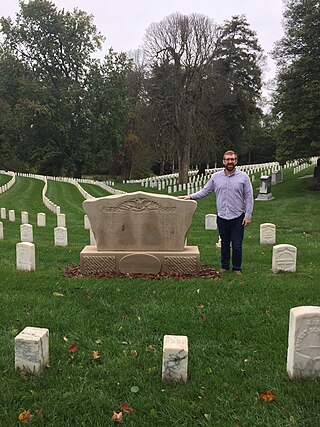
The 32nd Indiana Monument, also known as the August Bloedner Monument, honors the Union soldiers of the 32nd Indiana Volunteer Infantry Regiment, also known as Indiana's "1st German" regiment, who died in the Battle of Rowlett's Station on December 17, 1861, near Munfordville, Kentucky. Originally placed at Fort Willich, near Munfordville, in January 1862, the monument was moved to Cave Hill National Cemetery at Louisville, Kentucky, in June 1867. Due to its fragile condition, the monument was removed from the national cemetery in 2008. After undergoing conservation treatment at the University of Louisville, it was placed on display at the Frazier History Museum lobby in August 2010. Although it is no longer in its original location, the 32nd Indiana Monument is generally considered to be the oldest surviving memorial to the American Civil War. A replacement monument at Cave Hill National Cemetery was dedicated in December 2011.

The Greenwich Avenue Historic District is a historic district representing the commercial and civic historical development of the downtown area of the town of Greenwich, Connecticut. The district was listed on the National Register of Historic Places on August 31, 1989. Included in the district is the Greenwich Municipal Center Historic District, which was listed on the National Register the year before for the classical revival style municipal buildings in the core of Downtown. Most of the commercial buildings in the district fall into three broad styles, reflecting the period in which they were built: Italianate, Georgian Revival, and Commercial style. The district is linear and runs north–south along the entire length of Greenwich Avenue, the main thoroughfare of Downtown Greenwich, between U.S. Route 1 and the New Haven Line railroad tracks.

The Jackson First United Methodist Church is a historic church at 1022 College Ave. in Jackson, Kentucky. It was built in 1922. It was added to the National Register of Historic Places in 1986 as M.E. Church, South.
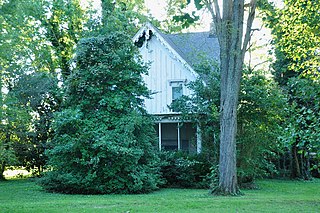
The White House in Christianburg, Kentucky, also known as Otto Minch House, is a Gothic Revival building from before 1882, perhaps much before. It is of frame construction with brick nogging. It was listed on the National Register of Historic Places in 1988.

Warwood Fire Station is a historic fire station located at Wheeling, Ohio County, West Virginia. It was built in 1923, and is a two-story, rectangular brick building in the Classical Revival-style. The three-bay front facade has two garage openings with a single center entrance. Its entablature is a centered limestone panel incised with "FIRE DEPARTMENT NO. 11."
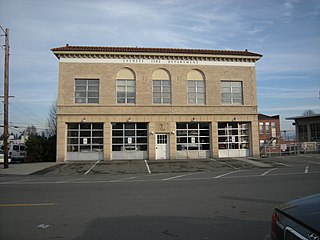
Everett Fire Station No. 2 is a historic building located in Everett, Washington.
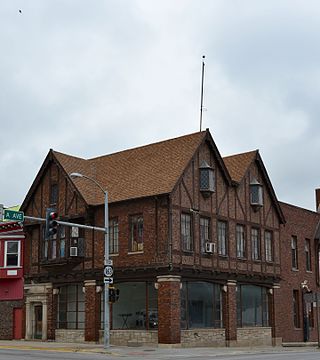
The Oskaloosa City Square Commercial Historic District is a 9.8-acre (4.0 ha) historic district in Oskaloosa, Iowa that includes Early Commercial, Italianate, and Romanesque Revival architecture. It was listed on the National Register of Historic Places in 1986. At the time of its nomination it included 68 contributing buildings.
The city of Birmingham, Alabama, saw a vast period of growth in the late 19th and early 20th centuries. With its growth came an expansion in city services, notably the fire department. A number of new stations were constructed from 1910 through 1929, many of which are still standing. Together, ten of these historic fire stations are listed on the National Register of Historic Places as part of the Historic Fire Stations of Birmingham Multiple Property Submission.

Union Station, also known as Atlantic Coast Line Railroad and Southern Railway Station, is a historic train station located at Columbia, South Carolina. It was built in 1902, and is a brick and stone, eclectic Jacobethan Revival / Tudor Revival building. It features stepped gables and towering chimneys. It was designed by architect Frank Pierce Milburn for the Atlantic Coast Line Railroad and Southern Railway. In contrast to the custom of 'union station' denoting the single station for several railroads, the Seaboard Air Line Railroad had its own station one-half mile away. The formerly Seaboard Silver Star still operates through another station in Columbia.

The Florence Downtown Historic District is a historic district in Florence, Alabama. Florence was founded in 1818 by the Cypress Land Company, who counted among its trustees Creek War General John Coffee, future Governor of Alabama Thomas Bibb, early Huntsville settler LeRoy Pope, and future United States Senator and Supreme Court Justice John McKinley. The company hired Italian surveyor Ferdinand Sannoner, who divided the land into over 400 lots and named the town after Florence, Italy. The first Lauderdale County Courthouse was completed in 1822, and the oldest extant building in the district, the Gothic Revival First Presbyterian Church, was completed two years later. Most of the early buildings was destroyed by a fire in 1866. Development resumed in earnest in the 1880s as Florence's industrial economy developed with the addition of several cotton mills, and the Florence Wagon Works, among others. Other booms occurred in the 1920s with the construction of Wilson Dam, the establishment of the Tennessee Valley Authority in the 1930s, and during World War II as metals and chemical plants were drawn to the area.

The James Martin House is a historic residence in Florence, Alabama. Martin was a leading Florence industrialist of the Antebellum era, who owned a cotton spinning mill along Cypress Creek. He had come to Florence from Jefferson County, Kentucky, and established his mill in 1839. A fire destroyed the complex in 1844, but was rebuilt and reopened in 1850. The mill was destroyed during the Civil War, but not rebuilt before Martin's death in 1869. Martin's sons operated the mill until 1873, and owned the house until 1879. It was purchased in 1886 by John Bounds, and remained in his family until 1974.

Indianapolis Fire Headquarters and Municipal Garage is a historic fire station and garage located at Indianapolis, Indiana. The Fire Headquarters was built in 1913 for the Indianapolis Fire Department, and is a three-story, Classical Revival style orange-brown glazed brick building with limestone detailing. It sits on a concrete foundation and has a square brick parapet. The Classical Revival style Municipal Garage was built in 1913, and expanded in 1925 with two Tudor Revival style additions.

Fire Station No. 2, also known as El Mecca Shrine Club, is a historic building located in Waterloo, Iowa, United States. The city's paid fire department dates from 1904. Prior to that Waterloo was served by private fire companies. Built in 1907, this is the only early fire station left in the city. This building is an eclectic combination of the Renaissance Revival and the Romanesque Revival styles. It was designed by the prominent Waterloo architect John G. Ralston. The decorative elements on the main floor are found in the columns with foliated capitals that support a broad entablature. The second story is primarily brick with lighter stone accents for a polychromatic effect. The building was used as a fire station until 1969 when the city built five new stations. Black Hawk County used the building as an office to issue food stamps. El Mecca Shrine acquired the building in 1976 and converted it into a restaurant and club. It was listed on the National Register of Historic Places in 1988.
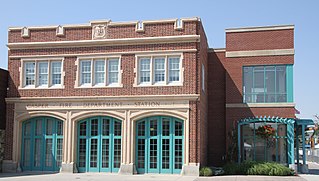
The Casper Fire Department Station No. 1, also known as Casper Municipal Garage and Fire Station, was built in 1921. It was listed on the National Register of Historic Places in 1993.

Cedar Rapids Central Fire Station, also known as Cedar Rapids Hose Company No. 1 and the Cedar Rapids Science Station, is a historic building located in Cedar Rapids, Iowa, United States. It served as the city's fire department headquarters and downtown fire station from 1918 to 1985. It replaced a frame structure in the northeast quadrant, and was part of a larger program of building new facilities for the local fire department. The building program was a response to a series of disastrous fires, changing technology, and the city's growth. This fire station served from the era of horse-drawn pumper wagons to the modern era of fire engines, pumpers, and hook and ladder trucks. The two-story, brick Mission and Spanish Colonial Revival structure was designed by local architect Charles A. Dieman. In the mid-20th century a two-story kitchen addition was built onto the back of the building.
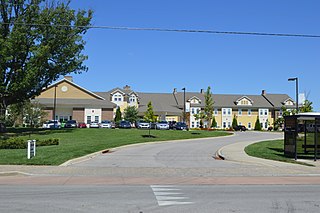
The John Delehunty House, at 212 Main St. in Florence, Kentucky, was a historic Tudor Revival-style house built in 1920.

Spur Gasoline Station, at 201 E. Bridge St. in Cynthiana, Kentucky, was built in 1925. It was listed on the National Register of Historic Places in 1987.

Santa Ana Fire Station Headquarters No. 1, at 1322 N. Sycamore St. in Santa Ana, California, is a fire station which was built in 1929. It was listed on the National Register of Historic Places in 1986.

The Kansas City, Kansas City Hall and Fire Headquarters is a pair of buildings at 805 and 815 N. Sixth St. in Kansas City, Kansas. The buildings are also known as Old City Hall and Main Fire Station. They were listed on the National Register of Historic Places in 1986.

The Fire Station No. 2 in Topeka, Kansas, at 719-723 Van Buren, is a fire station which was built in 1927. It was listed on the National Register of Historic Places in 2002 as Fire Station No. 2-Topeka.



















